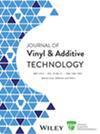Study of the bactericidal properties of polylactic acid-based 3D filament
Abstract
The spread of microorganisms is a global challenge for health, the environment, and the economy. Incorporating antibacterial agents into polymeric materials, such as polylactic acid (PLA), is an effective strategy. This study compared the incorporation of metallic (silver) and photocatalytic (titanium dioxide) fillers in 3D printed objects, evaluating their thermal stability, dispersion, crystalline structure, and antibacterial effectiveness. Various characterization techniques were used, including X-ray microfluorescence (μFRX), thermal stability, scanning electron microscopy (SEM), transmission electron microscopy (TEM), FT-IR spectroscopy, X-Ray diffraction (XRD), UV spectroscopy, X-ray photoelectron spectroscopy (XPS), and agent migration tests, along with antibacterial efficacy. The UV-activated photocatalytic materials showed a durable 99.99% efficacy against S. aureus and E. coli, emerging as a promising material for applications in medical, food, textile, electronic, and transportation sectors, enhancing hygiene through additive manufacturing.
Highlights
- Composite materials were made for additive manufacturing in an industrial setting.
- Antibacterial activity was tested on surfaces against E. coli and S. aureus.
- A comparison of the antibacterial efficacy of metallic and photocatalytic loads is done.
- Photocatalytic TiO2 loads with UV activation offer microbial benefits for manufacturing.





 求助内容:
求助内容: 应助结果提醒方式:
应助结果提醒方式:


